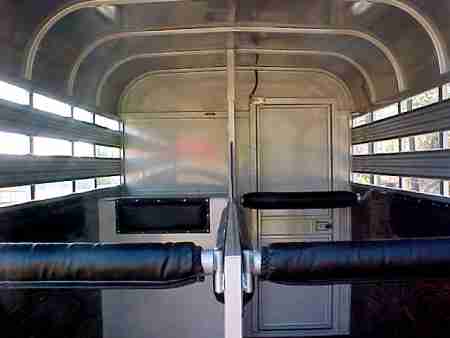Horse Trailers: 10 Must Have Safety Features to Look For

Structural Materials for Horse Trailers
Horse trailers are constructed from the base up using a variety of materials, including steel, aluminum and exotic alloys. Steel is an old standard, but it’s heavy and prone to rusting, aluminum is lightweight and rust-resistant, but lacks the strength of steel and can become brittle. A frame made from zinc alloy is the best of both worlds, with lots of strength in a very light weight metal. Your horses must be able to trust that your trailer’s structure isn’t going to shift or buckle during transport or you may spook them so badly after a long haul that they’ll never set foot inside again.
The skin of your horse trailer is equally important, after all, it’s the only thing protecting your horses from the various types of debris on the road. Zinc, aluminum and steel are popular skinning materials as well as framing materials, but consider how they’re attached before you commit. Riveted skins lack the flexibility of bonded skins, and a shiny skin will heat up much faster than a painted surface. From where your horse is standing, a painted, bonded skin is the very best option for the safest ride.
Horse Comfort is Vital to Safety
No matter if you’re looking for a used, off the floor trailer model or a brand new trailer, the safety of your passengers is paramount. When it comes to horses, comfort and safety are practically interchangeable -- after all, a comfortable horse is less likely to put himself into dangerous situations or try to break free in transit.
Even the best non-reflective ceiling can generate a lot of heat on a long trip, so keep an eye out for insulated ceilings if you intend to take your horses for a ride more than a few miles down the road. Heat can kill, and if your ceilings aren’t protecting your horse from the heat that builds up on long trips, you could end up with a stressed, sick or uncooperative horse at the end of your journey.
Floors are another place where heat can transfer into the trailer from the road. Aluminum floors are convenient and easy to clean, but they’re terrible for your horse because they transfer heat so readily from the pavement below. Look for pressure treated wood or rubber flooring to keep the road heat where it belongs. These surfaces are also easier for horses to stand on during travel, since they have a little more grip than aluminum alone.
Whether you’ve got straight load or slant load horse trailers on the brain, make sure they offer an extra padded divider between the end of the trailer and your horses. It may not seem like a big deal, but the first time one of your horses tries to bolt from the trailer prematurely, you’ll be thankful for the extra divider. An extra divider protects both you and your horses as you prepare them for unloading.
Along with extra dividers, you need to make sure your stalls and doors are as big as possible. Wide doors can help convince spooky horses to enter and exit the trailer without drama and the large stalls will make that same horse more comfortable on his trip. Horses aren’t designed for confinement, so by providing them spaces that look and feel open, they’re less likely to be afraid of traveling. You can also help increase their sense of ease by having the interior of your new trailer painted white in order to make it seem larger.
If your horse is still nervous in the trailer, you’ll be thankful if you opted for one of the best wall systems available. A nervous horse may paw or kick at the walls of the trailer, but with a thick liner made from plastic or rubber, the injury to your horse and your trailer will be minimal. Watch out for trailers that only offer 1/4 inch thick rubber pads covering hard backing plates -- these can injure your horse badly.
Extras that Aren’t Optional
Both a gooseneck horse trailer and a bumper pull horse trailer are capable of hauling a great deal of weight at very high speeds and neither is easy to stop if it gets loose from your vehicle. When looking at trailers, don’t bother with anything that lacks a breakaway brake. These backup brake systems are more than nifty safety features, they can save the lives of other drivers and your horses.
Escape doors aren’t always standard equipment on smaller trailers, but even a two horse trailer can become a very dangerous place if your horses aren’t being cooperative. Not only do escape doors help with loading horses that are still getting practice with the trailer, but they can get you out of tight spots if an irritated horse pins you in the corner. Look for big doors that will allow for fast escapes, don’t risk trying to escape through tiny doors.
Even big horse trailers with living quarters need efficient tack systems. Although they’re not really safety features, poorly designed tack systems can create bottlenecks at the end of the trailer that make it hard to load or unload your horse, or for you to escape when necessary. Tack systems that can be swung out of the trailer to allow full access to the back door are always the best option.
When it comes to horse trailer shopping, you have to balance price and longevity, but safety can’t be optional. The safer your trailer, the happier your horses will be and the less likely they are to fight you when it comes time to load or bolt at unloading time. Double D Trailers are built with safety first -- email us at sales@doubledtrailers.com to learn about the many safety features that are standard on all of our models.

